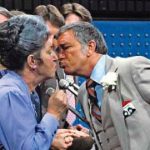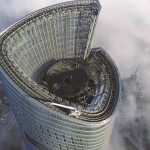Movies have come a long way over the years. The first movie, Roundhay Garden Scene, came out in 1888. It is known as a short film, but you’d be surprised by just how short it is. Roundhay Garden Scene runs for a total time of just 2.11 seconds long! While that may not sound like a movie by today’s standards, it is still considered the first movie ever made. But, let’s talk about the most famous movies because of CGI.
Back in the day, people used all sorts of creative methods to achieve fantastical effects. People used puppetry, robotics, prosthetics, and even stop-motion to achieve incredible effects. Nowadays, however, things are quite different.
CGI, or Computer-Generated Imagery, was invented in the 1950s. Alfred Hitchcock was the first director to use CGI in a film. The movie, Vertigo, came out in 1958. A few designers carefully used a WWII anti-aircraft targeting computer to create a spiraling effect that stunned audiences around the world.
However, many people fall under the misconception that using CGI is easier than the old methods of creating special effects. However, this could not be farther from the truth. Puppetry, robotics, stop-motion, and other forms of classic special effects require a great deal of time and talent. So does CGI, although a different skill-set is required.
Bad CGI
After all, we’ve all witnessed bad CGI. Creating good special effects on a computer takes time, effort, and a great deal of skill. The use of green screens makes work a lot easier for special effects artists. However, this can make actors’ jobs far more difficult! It’s not easy to stay in character when the entire set is one big green screen! Most actors today have to concentrate very hard to pull off their incredible performances.
In today’s video, we’re going to take a look at some of the special effects that have been used in films. Some of these examples will show just how much CGI can transform a scene, while others will show off some amazing practical effects that didn’t use CGI at all! Make sure you stick around until the very end of the video, where we’ll reveal the most amazing use of special effects before CGI was even invented!
Before we get started, be sure to like this video, and don’t forget to subscribe and click that notification bell so you can stay up to date with all of our videos!
Facts Verse Presents: How Special Effects Transformed the Most Famous Movies
Harry Potter
The Harry Potter series was an incredibly popular film franchise. Part of what makes the series so enchanting is the exciting and beautiful world where it takes place. The crew had to use plenty of special effects to make the world just as magical as the books. Even though it was a difficult task, everyone in the film worked hard to make Hogwarts come to life. After many long hours, they certainly did the castle justice!
For the first film, Harry Potter and the Philosopher’s Stone, the design team built an intricate 3D model of Hogwarts. Shots of the castle were then digitally enhanced to make it look as realistic as possible.
The film series also required tons of CGI for all of the spells and magical mischief that the main characters get into. For the famous scenes where Harry Potter flies on a broomstick, he was filmed in front of a green screen. While he still sat on a broom, the broom was carefully mounted to the floor, although that part was removed during the editing phase.
The Twilight Saga: Eclipse
Twilight was another popular film franchise, especially among younger women. In the series, Bella Swan is caught between two supernatural romances; a werewolf and a vampire. While the vampire, Edward, didn’t require as many special effects, the werewolf underwent quite a bit of CGI.
During the scenes where Jacob was transformed into a wolf, the actor had to wear a special suit. Later, the special effects team added CGI to make him look like a real wolf! During filming, however, it certainly looked odd. Kirsten Stewart probably had to work very hard to keep from laughing as she acted alongside that ridiculous suit!
2001: A Space Odyssey
2001: A Space Odyssey was released in 1968 when CGI was still relatively new. While director Stanley Kubrick certainly had the means to use this technology, he often chose to use practical effects instead. He commissioned a British aircraft company to build a rotating contraption similar to a Ferris wheel. It cost a whopping $750,000! The crew bolted all of the furniture and control panels to the surface of the machine and turned it on so that it rotated at a speed of three miles per hour. If you’re impressed by this expensive ship, click the like button!
The Lord of the Rings
While The Lord of the Rings came out long after CGI was invented, it still changed CGI forever. The crew used a combination of CGI and practical effects to achieve one of the most breathtaking trilogies in film history.
In this fantasy series, the hobbits and dwarves are much smaller than humans, wizards, and elves. To capture the height differences, they frequently used a method known as forced perspective. The crew used extreme camera angles to make it look as though the hobbits and dwarves were much shorter than the other characters. In some cases, they also used stunt doubles.
The most exciting part about the trilogy’s special effects, however, can be owed to the character Gollum. To bring this character to life, the special effects crew created an entirely new form of technology. With the help of Andy Serkis’ expressive movements, they were able to use motion capture technology and special CGI animation to make Gollum look as real as any other character in the film!
The Hobbit
The Hobbit trilogy was filmed a few years after The Lord of the Rings ended. However, by the time they began working on the film, technology had advanced considerably. As a result, the crew relied more heavily on CGI. Instead of using forced perspective like in The Lord of the Rings, actors who played characters of different sizes were filmed at separate times.
For example, this method was used in the scene where Gandalf sits inside Bilbo’s house with all of the dwarves partying around him. Sadly, while all of the dwarves and Bilbo were filmed at the same time, Ian McKellan, who played Gandalf, was filmed all alone. Poor McKellan was so heartbroken that he couldn’t act at the same time as the rest of the actors broke down on set. While CGI can be a great way to add a new layer of realism to a movie, it isn’t always best for everyone involved.
Alien
Perhaps one of the most iconic scenes in film history didn’t use CGI at all! The famous chest-bursting scene in the film Alien was done entirely through practical effects. The actor, John Hurt, had a hand puppet fixed to his chest. The crew built a fake chest piece made of fiberglass to put under his shirt, and they also put plenty of tubes filled with fake blood. The crew attached wires to the puppet so that, after it exploded from the actor’s chest, it could run across the table.
The most exciting part? None of the other actors on set knew what to expect, which means their shocked and terrified reactions were completely real!
Avatar
The film Avatar relied heavily on CGI to make the film an immersive and wondrous experience. The famous blue creatures were, of course, played by regular human actors. However, their appearance was devised entirely through CGI. This means the actors had to work in special motion capture suits so the special effects crew could add all of the CGI to the footage. Imagine acting in a weird suit all day long! That takes some serious dedication and acting skills.
Star Wars
The original Star Wars trilogy had a massive effect on special effects in the film world. The film Return of the Jedi used lots of CGI, but director George Lucas wasn’t afraid of going back to classic special effects at times. At first, George Lucas wanted the explosion of the Death Star to be animated with CGI. However, after thinking about it for a while, he decided to use practical effects, instead. The scene was filmed with a special motion-controlled camera. Above the camera was a box filled with black powder and titanium shavings. A crew member set the mixture on fire, and it exploded across the room, creating an amazing visual effect.
The Wizard of Oz
The Wizard of Oz was released in 1939, and the film was groundbreaking for countless reasons. The biggest reason the film became so famous is because it was the first movie ever released in technicolor. However, it also used some incredible special effects. Even though CGI hadn’t been invented yet, the technical crew spent tons of time producing a world that audiences would never forget.
The iconic tornado scene was comprised of two parts. While part of the footage was filmed from real tornadoes, the close-up shots were done with a very creative special effect. The crew filled a silk stocking with sand that was hung over a model of Dorothy’s farm. A miniature fan was pointed towards the “tornado” so that it twisted around and resembled the real-life natural phenomenon.
As you can see, film crews can create amazing effects through a variety of creative ways. Do you prefer practical special effects or effects made with CGI? Let us know in the comments below, and don’t forget to subscribe to Facts Verse for more videos!n order to


